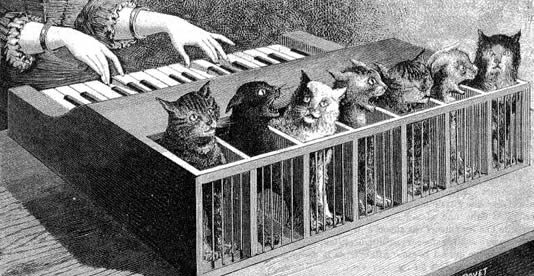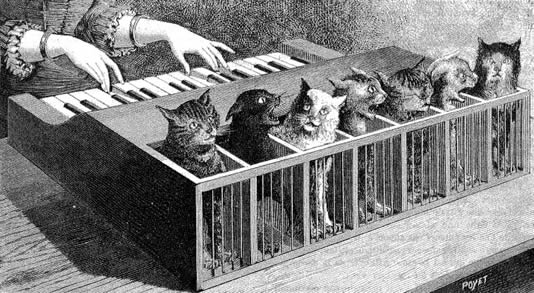The Cat’s Meow, Instrumentalized


In 1984, a guy named Charlie Schmidt took his cat named Fatso, dressed her up in a blue shirt, placed her in front of an electric keyboard, and then manipulated her arms so it looked like she was actually playing the pre-programmed music coming out of the instrument. And, oh yeah, he recorded the hijinx, likely intending to show it to a few friends. But a couple of decades later, something came along which changed all that: YouTube. On June 7, 2007 — nearly 23 years after he made the original recording — Schmidt uploaded this 54 seconds of silliness to the site seemingly made for cat videos. “Keyboard Cat” was born. You can watch the clip here, but there’s a good chance you’ve already seen it — the original video has more than 50 million views, and hundreds of copied clips litter the Internet.
While most people liked the video, some may object to Schmidt’s decision to use his pet as a prop for a joke. Regardless, one thing is for sure: it’s better to be a Keyboard Cat than in a Katzenklavier. From the cat’s perspective, that is.
What’s a katzenklavier? In English, it’s a “cat organ” or “cat piano.” Here’s an illustration.

Now if you’re wondering why that’s a drawing, there’s good news — the thing above was, as far as we know, never actually made. Be thankful for that, especially if you like cats, because it’s not a very pet-friendly instrument. It was the brainchild of Athanasius Kircher, a Jesuit scholar born in 1602. Smithsonian, citing translated versions of Kircher’s book on his proposed invention, explains how it was intended to work:
The player of such a piano would select “cats whose natural voices were at different pitches and arranged them in cages side by side, so that when a key on the piano was depressed, a mechanism drove a sharp spike in the appropriate cat’s tail.” The result, he wrote, would be “a melody of meows that became more vigorous as the cats became more desperate.”
If that doesn’t seem like something a man of the cloth would suggest — why intentionally cause pain for the sole purpose of creating some music (and not very good music at that)? — well, that’s because there’s a bit more to the story. As the Guardian explains, the katzenklavier “was actually invented for psychiatrists,” and specifically, to treat inattentiveness or to bring people out of a vegetative state:
An 18th-century German physician named Johann Christian Reil wrote that the device was intended to shake mental patients who had lost the ability to focus out of a “fixed state” and into “conscious awareness”. The patient must be placed so that they are sitting in direct view of the cats’ expressions when the psychiatrist plays a fugue on the infernal instrument.
The hope was that hearing the cats sing in agony would basically “wake” the patient out of whatever stupor he or she was in. And although again, there’s no record of this actually being put into practice, the idea kept popping up throughout the 17th and 18th centuries.
That’s a good thing, too — not just because it would be really mean to the cats. Musically, at least, the idea has a major flaw: as Mental Floss notes, individual cats don’t meow at a consistent pitch. (And we’re better off just watching videos of them pretending to play piano anyway.)
Bonus fact: Cat videos have become a staple of Internet culture, but their popularity predates the Internet by a long time. The first-ever cat video (more accurately, “cat film”) was created in 1894 by Thomas Edison. It features two cats wearing boxing gloves, having a boxing match in a makeshift cat-sized ring. Want to see for yourself? You can watch 22 seconds of it here — and that link takes you to YouTube, of course.
From the Archives: The Jon Arbuckle Society: What your cat thinks of you.
